Nonlinear Optical Properties of Zirconium Diselenide and Its Ultra-Fast Modulator Application
Abstract
:1. Introduction
2. Preparation and Characterization of ZrSe2-Based SAs
2.1. Preparation Process of ZrSe2 SAs
2.2. Characterization Results of ZrSe2 SAs
3. Experimental Setup
4. Results and Discussion
5. Conclusions
Author Contributions
Funding
Conflicts of Interest
References
- Sotor, J.; Sobon, G.; Abramski, L.M. Sub-130 fs mode-locked Er-doped fiber laser based on topological insulator. Opt. Express 2014, 22, 13244–13249. [Google Scholar] [CrossRef] [PubMed]
- Ming, N.; Tao, S.N.; Yang, W.Q.; Chen, Q.Y.; Sun, R.Y.; Wang, C.; Wang, S.Y.; Man, B.Y.; Zhang, H.N. Mode-locked Er-doped fiber laser based on PbS/CdS core/shell quantum dots as saturable absorber. Opt. Express 2018, 26, 9017–9026. [Google Scholar] [CrossRef] [PubMed]
- Xu, C.; Wise, F.W. Recent advances in fibre lasers for nonlinear microscopy. Nat. Photonics 2013, 7, 875–882. [Google Scholar] [CrossRef] [PubMed]
- Yan, P.; Liu, A.; Chen, Y.; Chen, H.; Ruan, S.; Guo, C.; Chen, S.; Li, I.L.; Yang, H.; Hu, J.; et al. Microfiber-based WS2-film saturable absorber for ultra-fast photonics. Opt. Mater. Express 2015, 5, 479–489. [Google Scholar] [CrossRef]
- Keller, U. Recent developments in compact ultrafast lasers. Nature 2003, 424, 831–838. [Google Scholar] [CrossRef] [PubMed]
- Zhang, H.N.; Liu, J. Gold nanobipyramids as saturable absorbers for passively Q-switched laser generation in the 1.1 μm region. Opt. Lett. 2016, 41, 1150–1152. [Google Scholar] [CrossRef]
- Fermann, M.E.; Hartl, I. Ultrafast fibre lasers. Nat. Photonics 2013, 7, 868–874. [Google Scholar] [CrossRef]
- Guo, B. 2D noncarbon materials-based nonlinear optical devices for ultrafast photonics. Chin. Opt. Lett. 2018, 16, 020004. [Google Scholar] [CrossRef]
- Yang, W.; Xu, N.; Zhang, H. Nonlinear absorption properties of indium selenide and its application for demonstrating pulsed Er-doped fiber laser. Laser Phys. Lett. 2018, 15, 105101. [Google Scholar] [CrossRef]
- Guo, Q.; Pan, J.; Li, D.; Shen, Y.; Han, X.; Gao, J.; Man, B.; Zhang, H.; Jiang, S. Versatile mode-locked operations in an Er-doped fiber laser with a film-type indium tin oxide saturable absorber. Nanomaterials 2019, 9, 701. [Google Scholar] [CrossRef]
- Guo, L.; Shang, X.; Zhao, R.; Zhang, H.; Li, D. Nonlinear optical properties of ferromagnetic insulator Cr2Ge2Te6 and its application for demonstrating pulsed fiber laser. Appl. Phys. Express 2019, 12, 082006. [Google Scholar] [CrossRef]
- Guo, Q.; Pan, J.; Liu, Y.; Si, H.; Lu, Z.; Han, X.; Gao, J.; Zuo, Z.; Zhang, H.; Jiang, S. Output energy enhancement in a mode-locked Er-doped fiber laser using CVD-Bi2Se3 as a saturable absorber. Opt. Express 2019, 27, 24670–24681. [Google Scholar] [CrossRef]
- Geim, A.K.; Novoselov, K.S. The rise of graphene. Nat. Mater. 2007, 6, 183–191. [Google Scholar] [CrossRef] [PubMed]
- Bao, Q.; Zhang, H.; Wang, Y.; Ni, Z.; Yan, Y.; Shen, Z.; Loh, K.P.; Tang, D. Atomic-layer graphene as a saturable absorber for ultrafast pulsed lasers. Adv. Funct. Mater. 2009, 19, 3077–3083. [Google Scholar] [CrossRef]
- Zhang, H.; Tang, D.; Zhao, L.; Bao, Q.; Loh, K.P. Large energy mode locking of an erbium-doped fiber laser with atomic layer graphene. Opt. Express 2009, 17, 17630–17635. [Google Scholar] [CrossRef] [PubMed]
- Zhang, H.; Tang, D.; Knize, R.J.; Zhao, L.; Bao, Q.; Loh, K.P. Graphene mode locked, wavelength-tunable, dissipative soliton fiber laser. Appl. Phys. Lett. 2010, 96, 1111112. [Google Scholar] [CrossRef]
- Zhang, H.; Tang, D.; Zhao, L.; Bao, Q.; Loh, K.P.; Lin, B.; Tjin, S.C. Compact graphene mode-locked wavelength-tunable erbium-doped fiber lasers: From all anomalous dispersion to all normal dispersion. Laser Phys. Lett. 2010, 7, 591–596. [Google Scholar] [CrossRef]
- Popa, D.; Sun, Z.; Torrisi, F.; Hasan, T.; Wang, F.; Ferrari, A.C. Sub 200 fs pulse generation from a graphene mode-locked fiber laser. Appl. Phys. Lett. 2010, 97, 203106. [Google Scholar] [CrossRef] [Green Version]
- Sun, Z.; Hasan, T.; Torrisi, F.; Popa, D.; Privitera, G.; Wang, F.; Bonaccorso, F.; Basko, D.M.; Ferrari, A.C. Graphene mode-locked ultrafast laser. ACS Nano 2010, 4, 803–810. [Google Scholar] [CrossRef]
- Sun, Z.; Popa, D.; Hasan, T.; Torrisi, F.; Wang, F.; Kelleher, E.J.R.; Travers, J.C.; Nicolosi, V.; Ferrari, A.C. A stable, wideband tunable, near transform-limited, graphene-mode-locked, ultrafast laser. Nano Res. 2010, 3, 653–660. [Google Scholar] [CrossRef] [Green Version]
- Bonaccorso, F.; Sun, Z.; Hasan, T.; Ferrari, A.C. Graphene photonics and optoelectronics. Nat. Photonics 2010, 4, 611–622. [Google Scholar] [CrossRef] [Green Version]
- Wang, Z.T.; Chen, Y.; Zhao, C.J.; Zhang, H.; Wen, S.C. Switchable dual-wavelength synchronously Q-switched erbium-doped fiber laser based on graphene saturable absorber. IEEE Photonics J. 2012, 4, 869–876. [Google Scholar] [CrossRef]
- Jung, M.; Koo, J.; Park, J.; Song, Y.; Jhon, Y.M.; Lee, K.; Lee, S.; Lee, J.H. Mode-locked pulse generation from an allfiberized, Tm-Ho-codoped fiber laser incorporating a graphene oxide-deposited sidepolished fiber. Opt. Express 2013, 21, 20062–20072. [Google Scholar] [CrossRef] [PubMed]
- Tolstik, N.; Sorokin, E.; Sorokina, I.T. Graphene mode-locked Cr:ZnS laser with 41 fs pulse duration. Opt. Express 2014, 22, 5564–5571. [Google Scholar] [CrossRef]
- Luo, A.P.; Zhu, P.F.; Liu, H.; Zheng, X.W.; Zhao, N.; Liu, M.; Cui, H.; Luo, Z.C.; Xu, W.C. Microfiber-based, highly nonlinear graphene saturable absorber for formation of versatile structural soliton molecules in a fiber laser. Opt. Express 2014, 22, 27019–27025. [Google Scholar] [CrossRef] [PubMed]
- Huang, S.; Wang, Y.; Yan, P.; Zhao, J.; Li, H.; Lin, R. Tunable and switchable multi-wavelength dissipative soliton generation in a graphene oxide mode-locked Yb-doped fiber laser. Opt. Express 2014, 22, 11417–11426. [Google Scholar] [CrossRef] [PubMed]
- Wan, H.; Cai, W.; Wang, F.; Jiang, S.; Xu, S.; Liu, J. High-quality monolayer graphene for bulk laser mode-locking near 2 μm. Opt. Quant. Electron. 2015, 48, 1–8. [Google Scholar] [CrossRef]
- Martinez, A.; Sun, Z. Nanotube and graphene saturable absorbers for fibre lasers. Nat. Photonics 2013, 7, 842–845. [Google Scholar] [CrossRef]
- Hsieh, D.; Qian, D.; Wray, L.; Xia, Y.; Hor, Y.S.; Cava, R.J.; Hasan, M.Z. A topological Dirac insulator in a quantum spin Hall phase. Nature 2008, 452, 970–974. [Google Scholar] [CrossRef] [Green Version]
- Zhang, H.; Liu, C.X.; Qi, X.L.; Dai, X.; Fang, Z.; Zhang, S.C. Topological insulators in Bi2Se3, Bi2Te3 and Sb2Te3 with a single Dirac cone on the surface. Nat. Phys. 2009, 5, 438–442. [Google Scholar] [CrossRef]
- Luo, Z.C.; Liu, M.; Liu, H.; Zheng, X.W.; Luo, A.P.; Zhao, C.J.; Zhang, H.; Wen, S.C.; Xu, W.C. 2 GHz passively harmonic mode-locked fiber laser by a microfiber-based topological insulator saturable absorber. Opt. Lett. 2013, 38, 5212–5215. [Google Scholar] [CrossRef] [PubMed]
- Liu, H.; Zheng, X.W.; Liu, M.; Zhao, N.; Luo, A.P.; Luo, Z.C.; Xu, W.C.; Zhang, H.; Zhao, C.J.; Wen, S.C. Femtosecond pulse generation from a Topological Insulator mode-locked fiber laser. Opt. Express 2014, 22, 6868–6873. [Google Scholar] [CrossRef]
- Xu, N.N.; Ming, N.; Han, X.L.; Man, B.Y.; Zhang, H. Large-energy passively Q-switched Er-doped fiber laser based on CVD-Bi2Se3 as saturable absorber. Opt. Mater. Express 2019, 9, 373–383. [Google Scholar] [CrossRef]
- Lin, Y.S.; Yang, C.Y.; Lin, S.F.; Tseng, W.H.; Bao, Q.; Wu, C.I.; Lin, G.R. Soliton compression of the erbium-doped fiber laser weakly started mode-locking by nanoscale p-type Bi2Te3 topological insulator particles. Laser Phys. Lett. 2014, 11, 055107. [Google Scholar] [CrossRef]
- Sotor, J.; Sobon, G.; Macherzynski, W.; Abramski, K.M. Harmonically mode-locked Er-doped fiber laser based on a Sb2Te3 topological insulator saturable absorber. Laser Phys. Lett. 2014, 11, 055102. [Google Scholar] [CrossRef]
- Xu, H.; Wan, X.; Ruan, Q.; Yang, R.; Du, T.; Chen, N.; Cai, Z.; Luo, Z. Effects of nanomaterial saturable absorption on passively mode-locked fiber lasers in anomalous dispersion regime: Simulations and experiments. IEEE J. Sel. Top. Quant. 2018, 24, 1100209. [Google Scholar] [CrossRef]
- Wang, K.; Wang, J.; Fan, J.; Lotya, M.; Neill, A.O.; Fox, D.; Feng, Y.; Zhang, X.; Jiang, B.; Zhao, Q.; et al. Ultrafast Saturable Absorption of Two-Dimensional MoS2 Nanosheets. ACS Nano 2013, 7, 9260–9267. [Google Scholar] [CrossRef]
- Hu, Q.Y.; Zhang, X.Y.; Liu, Z.J.; Li, P.; Li, M.; Cong, Z.H.; Qin, Z.G.; Chen, X.H. High-order harmonic mode-locked Yb-doped fiber laser based on a SnSe2 saturable absorber. Opt. Laser Technol. 2019, 119, 105639. [Google Scholar] [CrossRef]
- Mao, D.; She, X.; Du, B.; Yang, D.; Zhang, W.; Song, K.; Cui, X.; Jiang, B.; Peng, T.; Zhao, J. Erbium-doped fiber laser passively mode locked with few-layer WSe2/MoSe2 nanosheets. Sci. Rep. 2016, 6, 23583. [Google Scholar] [CrossRef]
- Li, J.; Zhao, Y.; Chen, Q.; Niu, K.; Sun, R.; Zhang, H. Passively mode-locked ytterbium-doped fiber laser based on SnS2 as saturable absorber. IEEE Photonics J. 2017, 9, 1506707. [Google Scholar] [CrossRef]
- Mao, D.; Cui, X.; Gan, X.; Li, M.; Zhang, W.; Lu, H.; Zhao, J. Passively Q-switched and mode-locked fiber laser based on a ReS2 saturable absorber. IEEE J. Sel. Top. Quant. 2018, 24, 1100406. [Google Scholar] [CrossRef]
- Chen, Y.; Jiang, G.; Chen, S.; Guo, Z.; Yu, X.; Zhao, C.; Zhang, H.; Bao, Q.; Wen, S.; Tang, D.; et al. Mechanically exfoliated black phosphorus as a new saturable absorber for both Q-switching and mode-locking laser operation. Opt. Express 2015, 23, 12823–12833. [Google Scholar] [CrossRef] [PubMed]
- Sotor, J.; Sobon, G.; Kowalczyk, M.; Macherzynski, W.; Paletko, P.; Abramski, K.M. Ultrafast thulium-doped fiber laser mode locked with black phosphorus. Opt. Lett. 2015, 40, 3885–3888. [Google Scholar] [CrossRef] [PubMed]
- Luo, Z.C.; Liu, M.; Guo, Z.N.; Jiang, X.F.; Luo, A.P.; Zhao, C.J.; Yu, X.F.; Xu, W.C.; Zhang, H. Microfiber-based few-layer black phosphorus saturable absorber for ultra-fast fiber laser. Opt. Express 2015, 23, 20030–20039. [Google Scholar] [CrossRef] [PubMed]
- Ma, J.; Lu, S.; Guo, Z.; Xu, X.; Zhang, H.; Tang, D.; Fan, D. Few-layer black phosphorus based saturable absorber mirror for pulsed solid-state lasers. Opt. Express 2015, 23, 22643–22648. [Google Scholar] [CrossRef] [PubMed]
- Xu, Y.; Wang, Z.; Guo, Z.; Huang, H.; Xiao, Q.; Zhang, H.; Yu, X.F. Solvothermal synthesis and ultrafast photonics of black phosphorus quantum dots. Adv. Opt. Mater. 2016, 4, 1223–1229. [Google Scholar] [CrossRef]
- Jin, X.; Hu, G.; Zhang, M.; Hu, Y.; Owen, T.A.; Howe, R.C.T.; Wu, T.C.; Wu, Q.; Zheng, Z.; Hasan, T. 102 fs pulse generation from a long-term stable, inkjet-printed black phosphorus-mode-locked fiber laser. Opt. Express 2018, 26, 12506–12513. [Google Scholar] [CrossRef]
- Jaiswal, H.N.; Liu, M.; Shahi, S.; Yao, F.; Zhao, Q.; Xu, X.; Li, H. Localized surface plasmon resonance on two-dimensional HfSe2 and ZrSe2. Semicond. Sci. Technol. 2018, 33, 124014. [Google Scholar] [CrossRef]
- Muhammad, Z.; Mu, K.; Lv, H.; Wu, C.; Rehman, Z.U.; Habib, M.; Sun, Z.; Wu, X.; Song, L. Electron doping induced semiconductor to metal transitions in ZrSe2 layers via copper atomic intercalation. Nano Res. 2018, 11, 4914–4922. [Google Scholar] [CrossRef]
- Zhao, X.; Zhang, H.; Chen, T.; Gao, Y.; Wang, H.; Wang, T.; Wei, S. Modulating electronic and magnetic properties of monolayer ZrSe2 by doping. Superlattice. Microst. 2018, 120, 659–669. [Google Scholar] [CrossRef]
- Ōnuki, Y.; Inada, R.; Tanuma, S.; Yamanaka, S.; Kamimura, H. Electrochemical characteristics of TiS2, ZrSe2 and VSe2 in secondary lithium battery. Jpn. J. Appl. Phys. 1981, 20, 1583–1588. [Google Scholar] [CrossRef]
- Hankare, P.P.; Asabe, M.R.; Kokate, A.V.; Delekar, S.D.; Sathe, D.J.; Mulla, I.S.; Chougule, B.K. Effect of annealing on properties of ZrSe2 thin films. J. Cryst. Growth 2006, 294, 254–259. [Google Scholar] [CrossRef]
- Jiang, H. Structural and electronic properties of ZrX2 and HfX2 (X = S and Se) from first principles calculations. J. Chem. Phys. 2011, 134, 204705. [Google Scholar] [CrossRef] [PubMed]
- Valero, S.M.; López, V.G.; Cantarero, A.; Galbiati, M. Raman spectra of ZrS2 and ZrSe2 from bulk to atomically thin layers. Appl. Sci. 2016, 6, 264. [Google Scholar] [CrossRef]
- Mleczko, M.J.; Zhang, C.; Lee, H.R.; Kuo, H.H.; Köpe, B.M.; Moore, R.G.; Shen, Z.X.; Fisher, I.R.; Nishi, Y.; Pop, E. HfSe2 and ZrSe2: Two-dimensional semiconductors with native high-κ oxides. Sci. Adv. 2017, 3, e1700481. [Google Scholar] [CrossRef]
- Zhang, W.; Huang, Z.; Zhang, W.; Li, Y. Two-dimensional semiconductors with possible high room temperature mobility. Nano Res. 2014, 7, 1731–1737. [Google Scholar] [CrossRef] [Green Version]
- Ding, G.; Gao, G.Y.; Huang, Z.; Zhang, W.; Yao, K. Thermoelectric properties of monolayer MSe2 (M = Zr, Hf): Low lattice thermal conductivity and a promising figure of merit. Nanotechnology 2016, 27, 375703. [Google Scholar] [CrossRef]
- Grimme, S.; Antony, J.; Ehrlich, S.; Krieg, H. A consistent and accurate ab initio parametrization of density functional dispersion correction (DFT-D) for the 94 elements H-Pu. J. Chem. Phys. 2010, 132, 154104. [Google Scholar] [CrossRef]
- Yüksek, M.; Kürüm, U.; Yaglioglu, H.G.; Elmali, A.; Ateş, A. Nonlinear and saturable absorption characteristics of amorphous InSe thin films. J. Appl. Phys. 2010, 107, 033115. [Google Scholar] [CrossRef]
- Heebner, J.E.; Wong, V.; Schweinsberg, A.; Boyd, R.W.; Jackson, D.J. Optical transmission characteristics of fiber ring resonators. IEEE J. Quantum Electron. 2004, 40, 726–730. [Google Scholar] [CrossRef]
- Haye, P.D.; Schliesser, A.; Arcizet, O.; Wilken, T.; Holzwarth, R.; Kippenberg, T. Opticalfrequency comb generation from a monolithic microresonator. Nature 2007, 450, 1214–1217. [Google Scholar]
- Mao, D.; Jiang, B.; Zhang, W.; Zhao, J. Pulse-state switchable fiber laser mode-locked by carbon nanotubes. IEEE Photon. Technol. Lett. 2015, 27, 253–256. [Google Scholar] [CrossRef]
- Mao, D.; Zhang, S.; Wang, Y.; Gan, X.; Zhang, W.; Mei, T.; Wang, Y.; Wang, Y.; Zeng, H.; Zhao, J. WS2 saturable absorber for dissipative soliton mode locking at 1.06 and 1.55 µm. Opt. Express 2015, 23, 27509–27519. [Google Scholar] [CrossRef] [PubMed]
- Guo, B.; Yu, Q.L.; Yao, Y.; Wang, P. Direct generation of dip-type sidebands from WS2 mode-locked fiber laser. Opt. Mater. Express 2016, 6, 2475–2486. [Google Scholar] [CrossRef]
- Wang, S.; Yu, H.; Zhang, H.; Wang, A.; Zhao, M.; Chen, Y.; Mei, L.; Wang, J. Broadband few-layer MoS2 saturable absorbers. J. Adv. Mater. 2014, 26, 3538–3544. [Google Scholar] [CrossRef]
- Xu, N.; Yang, W.; Zhang, H. Nonlinear saturable absorption properties of indium selenide and its application for demonstrating a Yb-doped mode-locked fiber laser. Opt. Mater. Express 2018, 8, 3092. [Google Scholar] [CrossRef]
- Niu, K.; Sun, R.; Chen, Q.; Man, B.; Zhang, H. Passively mode-locked Er-doped fiber laser based on SnS2 nanosheets as a saturable absorber. Photonics Res. 2018, 6, 72–76. [Google Scholar] [CrossRef]
- Niu, K.; Chen, Q.; Sun, R.; Man, B.; Zhang, H. Passively Q-switched erbium-doped fiber laser based on SnS2 saturable absorber. Opt. Mater. Express 2017, 7, 3934–3943. [Google Scholar] [CrossRef]
- Peng, J.; Zhan, L.; Gu, G.; Qian, K.; Luo, S.; Shen, Q. Direct generation of 128-fs Gaussian pulses from a compensation-free fiber laser using dual mode-locking mechanisms. Opt. Commun. 2012, 285, 731–733. [Google Scholar] [CrossRef]
- Noske, D.U.; Pandit, N.; Taylor, J.R. Source of spectral and temporal instability in soliton fiber lasers. Opt. Lett. 1992, 17, 1515–1517. [Google Scholar] [CrossRef]
- Smith, N.J.; Blow, K.J.; Andonovic, I. Sideband generation through perturbations to the average soliton model. J. Lightw. Technol. 1992, 10, 1329–1333. [Google Scholar] [CrossRef]
- Kelly, S.M.J. Characteristic sideband instability of periodically amplified average soliton. Electron. Lett. 1992, 28, 806–807. [Google Scholar] [CrossRef]
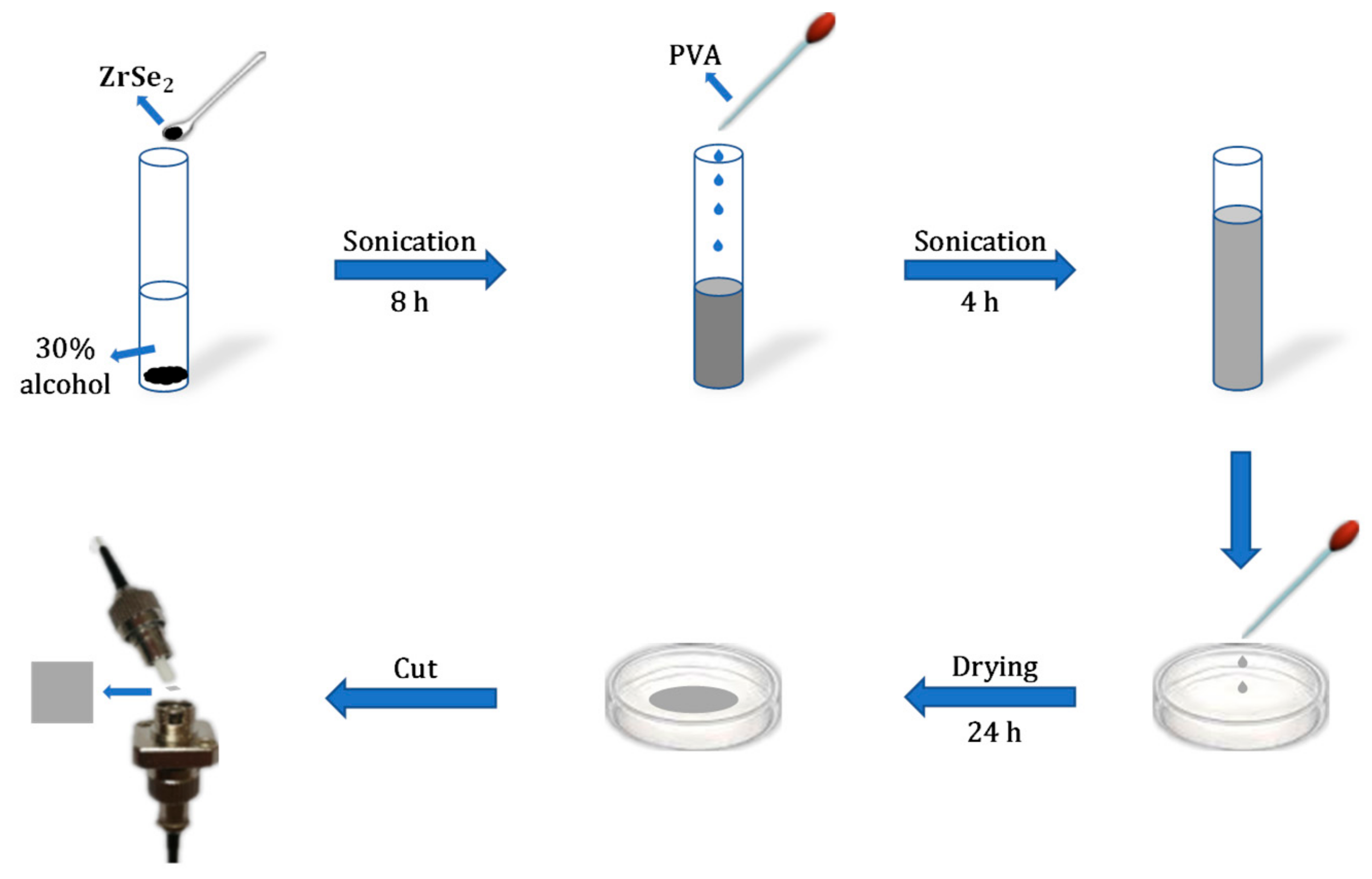
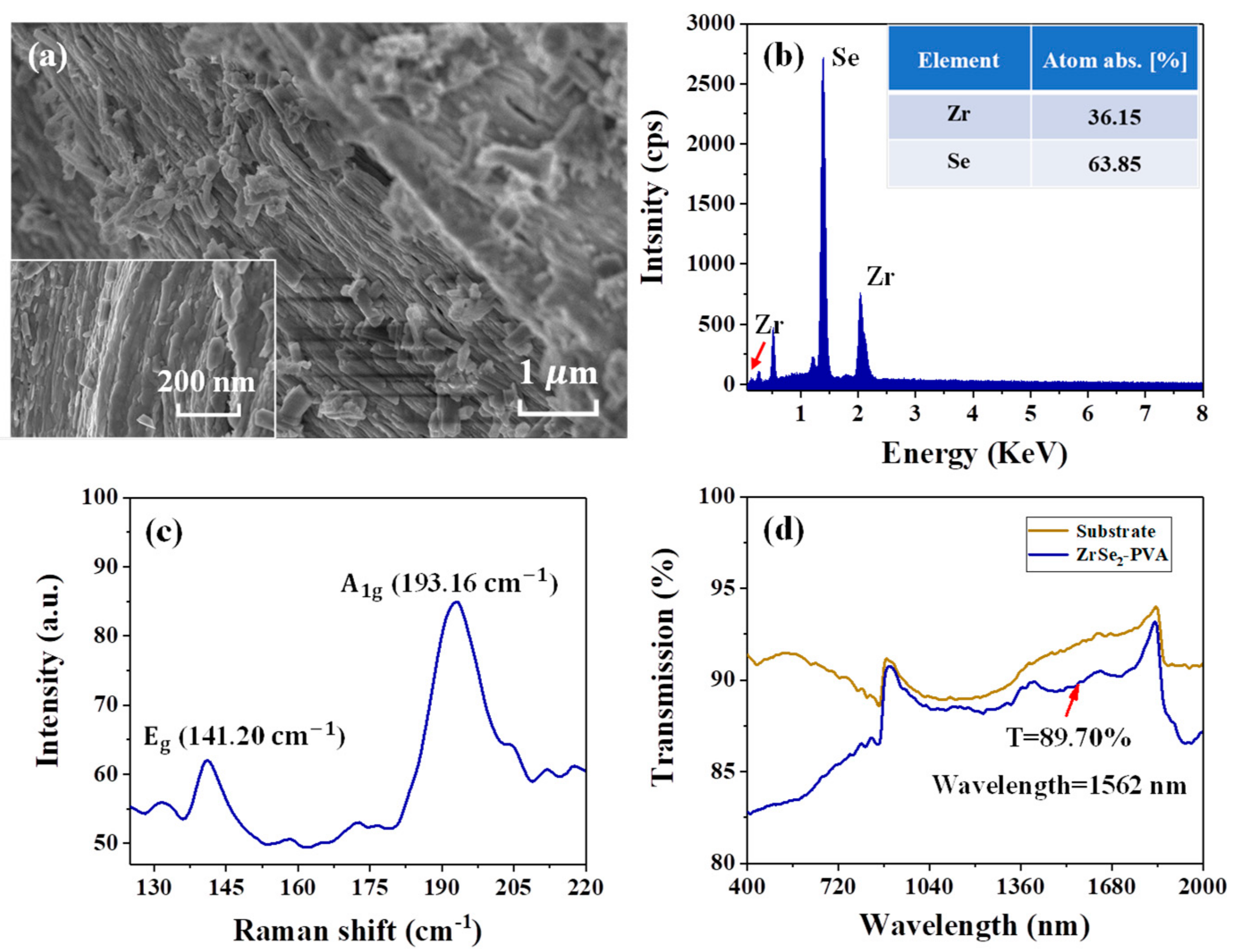
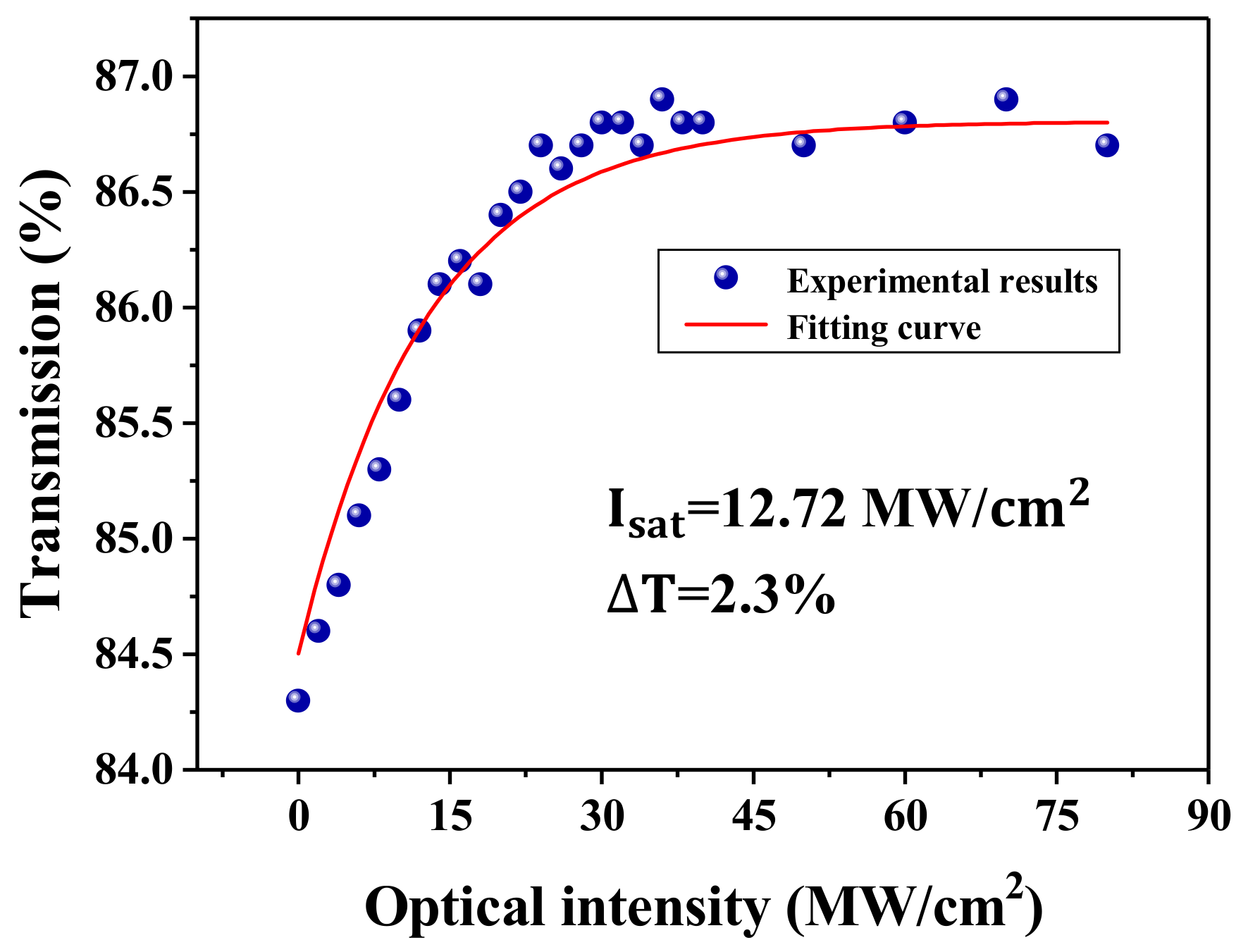
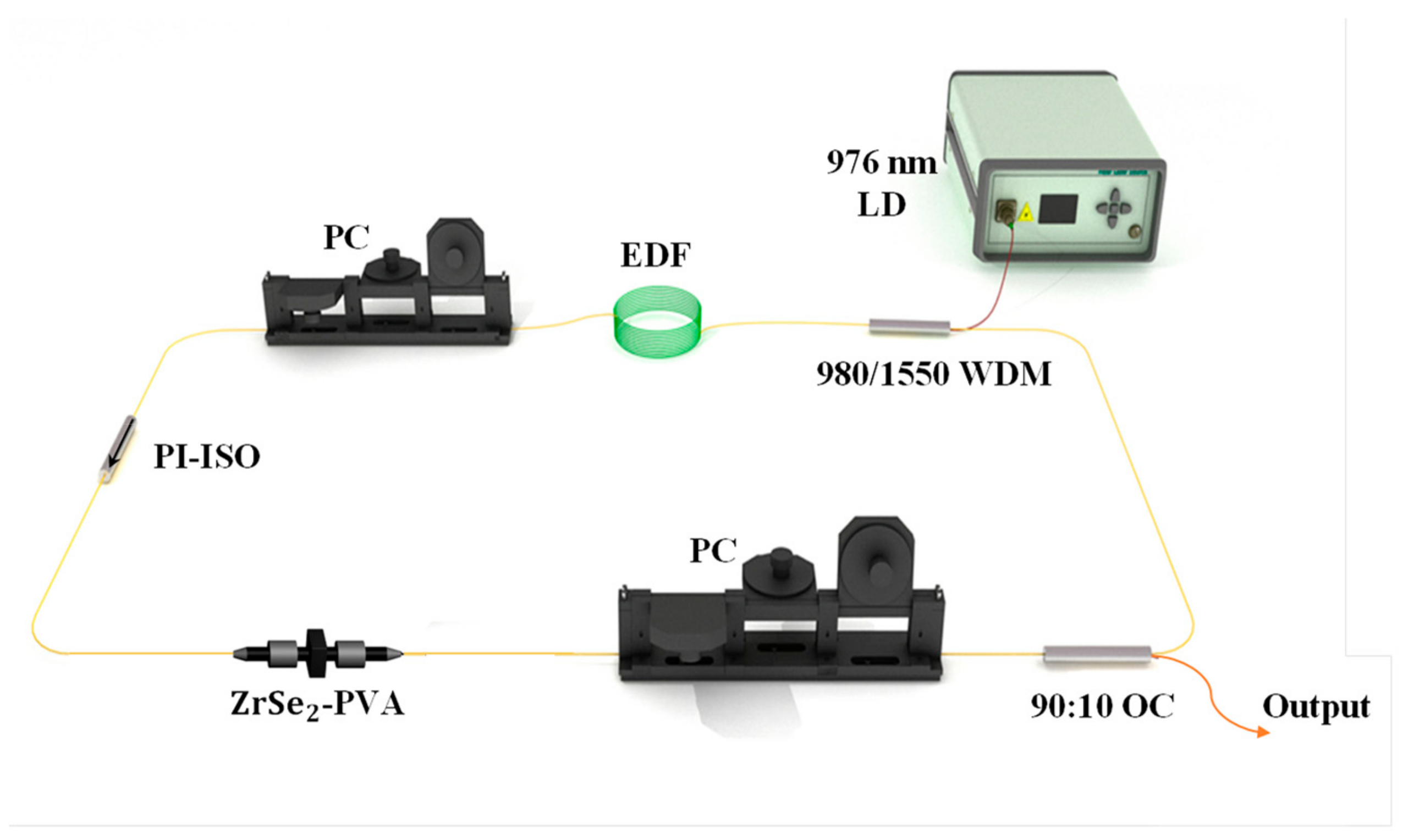
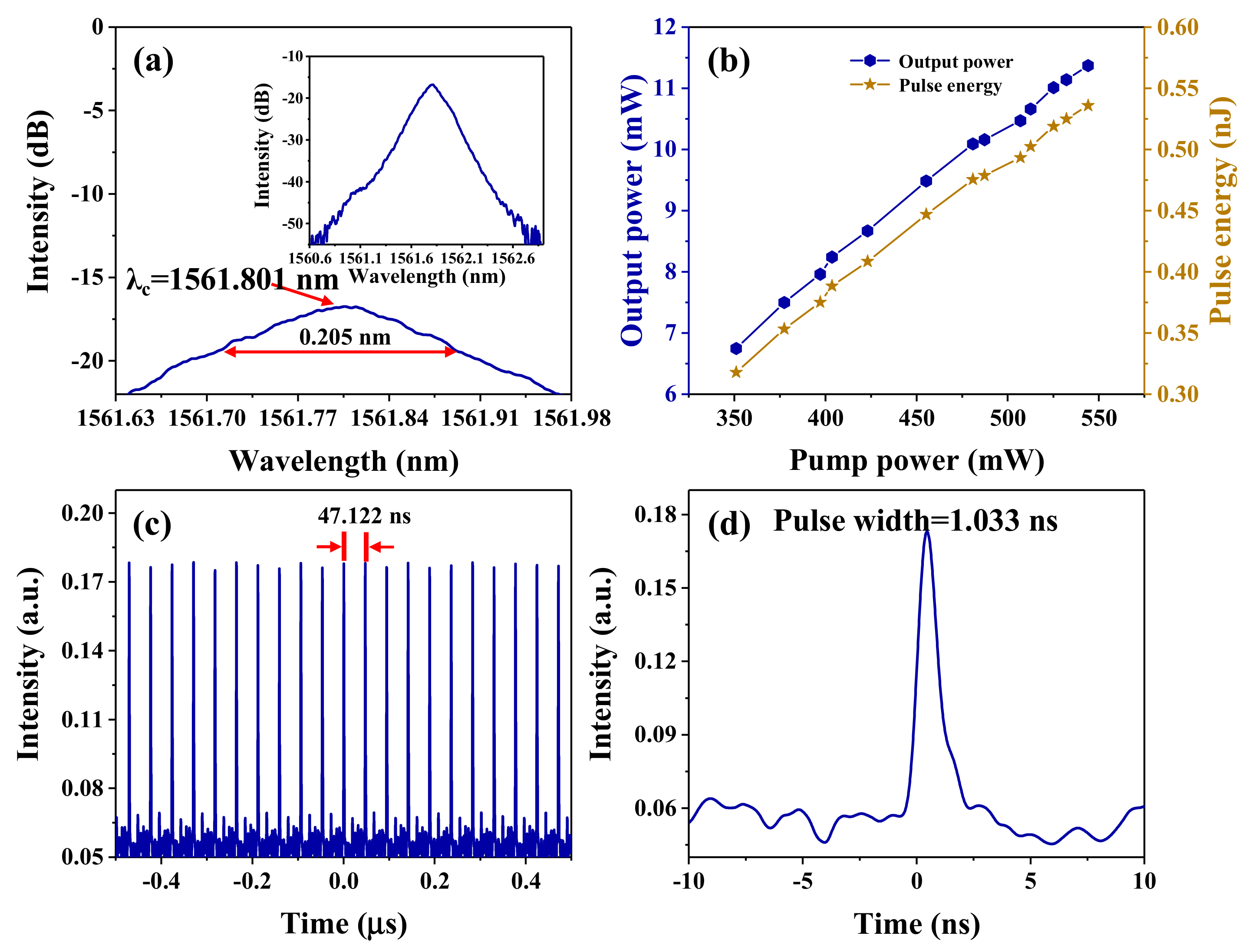
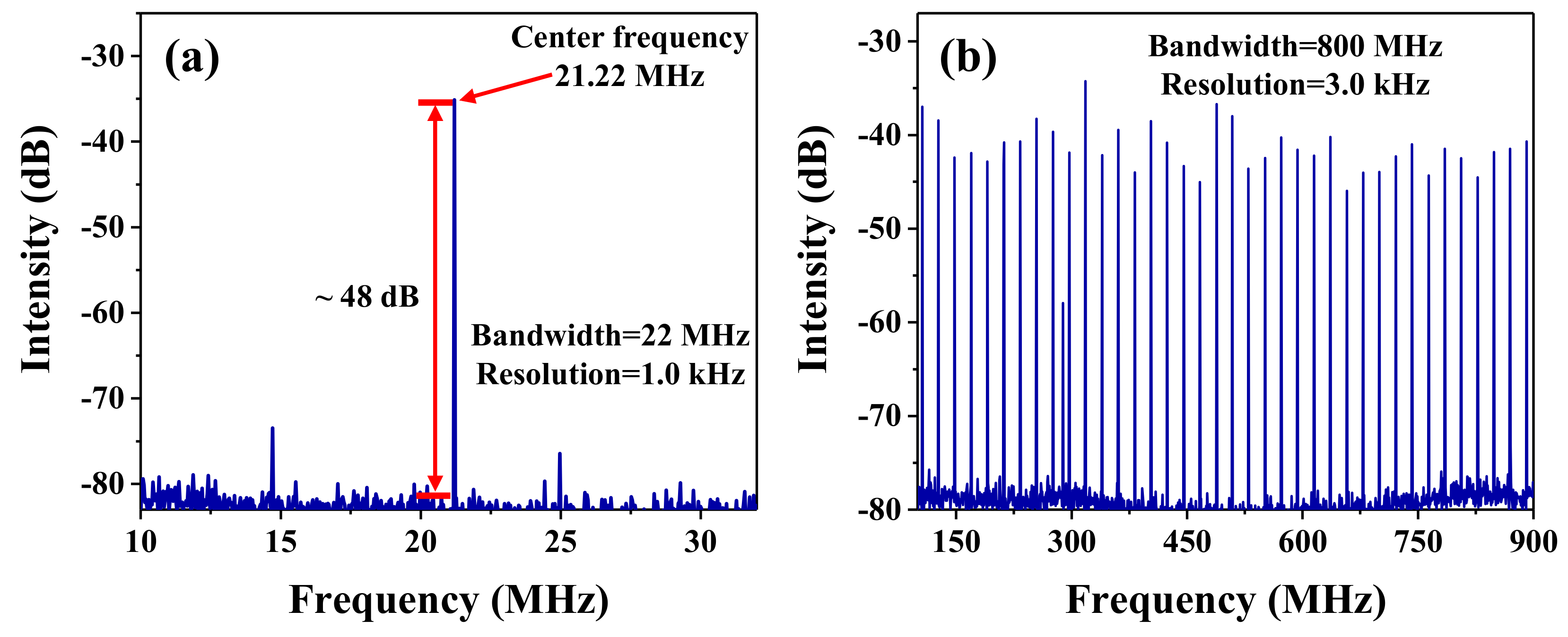
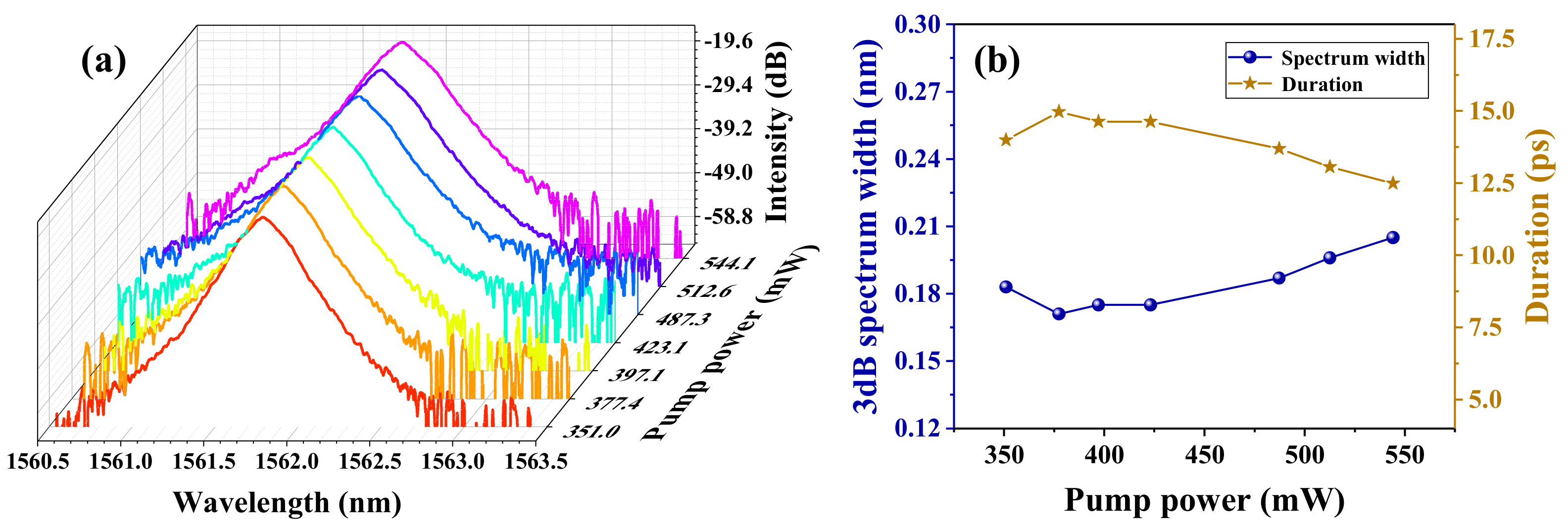
© 2019 by the authors. Licensee MDPI, Basel, Switzerland. This article is an open access article distributed under the terms and conditions of the Creative Commons Attribution (CC BY) license (http://creativecommons.org/licenses/by/4.0/).
Share and Cite
Wang, M.; Zheng, Y.; Guo, L.; Chen, X.; Zhang, H.; Li, D. Nonlinear Optical Properties of Zirconium Diselenide and Its Ultra-Fast Modulator Application. Nanomaterials 2019, 9, 1419. https://doi.org/10.3390/nano9101419
Wang M, Zheng Y, Guo L, Chen X, Zhang H, Li D. Nonlinear Optical Properties of Zirconium Diselenide and Its Ultra-Fast Modulator Application. Nanomaterials. 2019; 9(10):1419. https://doi.org/10.3390/nano9101419
Chicago/Turabian StyleWang, Mengxiao, Yue Zheng, Linguang Guo, Xiaohan Chen, Huanian Zhang, and Dengwang Li. 2019. "Nonlinear Optical Properties of Zirconium Diselenide and Its Ultra-Fast Modulator Application" Nanomaterials 9, no. 10: 1419. https://doi.org/10.3390/nano9101419
APA StyleWang, M., Zheng, Y., Guo, L., Chen, X., Zhang, H., & Li, D. (2019). Nonlinear Optical Properties of Zirconium Diselenide and Its Ultra-Fast Modulator Application. Nanomaterials, 9(10), 1419. https://doi.org/10.3390/nano9101419



